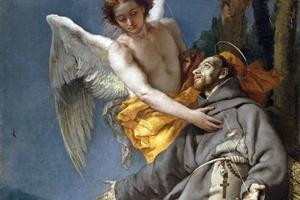The Door of Decision for St. Francis of Assisi
Excavations of a medieval door in the town of Assisi give new meaning to an old story

Tucked away in the Umbrian hills, the Italian town of Assisi is a haven of peace and tranquility. However, in late September and early October, the city drew public attention, hosting several important visitors.
On Sept. 24, Pope Francis visited Assisi for the “Economy of Francesco,” an event that discussed new, more sustainable ways to live and work.
On Oct. 4, Sergio Mattarella, the Italian President, traveled to Assisi to mark the 25th anniversary of the earthquakes that hit Umbria in 1997. Bishop Domenico Sorrentino is pleased that “his” town is a magnet for pilgrims of all backgrounds — papal, presidential or private. After all, Assisi has many attractions, but the bishop is working on adding one more.
Despite earthquakes and the wear of hundreds of years, Assisi has maintained the look and feel of a medieval city. However, over time the city has built up on its old self. Underneath the buildings lie the remains of the town that existed in St. Francis’ time. And, in the last few years, the bishop of Assisi, Bishop Domenico Sorrentino, has led a project excavating the places that were important in St. Francis’ life.
“We found the ancient facade of the bishop’s residence,” he told the National Catholic Register in September. Through this discovery, their excavations uncovered various other sites of historic importance. However, one excavation bears special significance for the life of St. Francis. It’s a door, dating to the Middle Ages, that leads from the old square into the bishop’s residence.
“This door was the door of decision for Francis, the door of conversion, because when he came here, he decided to renounce all of his earthly goods,” Bishop Sorrentino said.
Passing through this door punctuated a change in the life of Francis. As a youth, he lived a life of excess. The son of a cloth merchant and one of Assisi’s richest men, Francis led the youth of the town in heavy feasting and excessive spending. As Thomas of Celano, Francis’ biographer and one of his early disciples, describes, “Maliciously advancing beyond all of his peers in vanities, he proved himself a more excessive inciter of evil and zealous imitator of foolishness.” What Thomas of Celano cites as Francis’ foolish acts of evil were his lavish possessions and his copious expenditures.
Francis’ conversion, however, changed all of that. Hearing Jesus speak to him from the Cross of San Damiano, he changed his life from one devoted to selfish pleasure to a life in the service of others. Instead of spending his family riches on clothes and food for himself and his friends, he sold his father’s possessions and gave the proceeds to the priest of the local church of San Damiano to fund renovations of the building.
Angered at the way in which his son was burning through his savings, Francis’ father imprisoned him and dragged him in front of the bishop of Assisi, Bishop Sorrentino’s predecessor. On entering through the door to the bishop’s residence, Francis stripped himself of his clothes and handed them to his father, declaring that it was “no longer father Pietro di Bernardone, but our Father who art in heaven” to whom he owed his allegiance. Renouncing his worldly possessions, he devoted himself entirely to a life of service to Christ.
“And it is beautiful that he entered the door as one of the richest people in Assisi, and he went out the poorest,” said Bishop Sorrentino, describing the transformation that Francis underwent, passing through this door.
“He had made a decision that corresponded to the radicalism of the Gospel.” This decision, Sorrentino believes, allowed St. Francis to live his life in service to God and to the poor.
“This is really the impressive sense of this door,” he said. “I hope that many people will come here to walk through it and to reflect on their lives, and to say, ‘Where and how am I living? For whom or for what am I living?’ It is tempting to live our whole lives with a foot on one side, and a foot on the other side of this threshold. But we must make a decision.”
In addition to the excavation work, Bishop Sorrentino has compiled a short booklet chronicling the moments in which the door features in St. Francis’ life.
For Bishop Sorrentino, the events that happened at this door are not simply historical happenings. In uncovering the door, he hopes the stories will allow others to experience the same moments of reconciliation and decision as Francis, here in Assisi.
Bishop Sorrentino hopes to turn the room into which the door leads into a room of contemplation, confession and prayer. Assisi was a place of conversion, reconciliation and peace for St. Francis and has been an important city for many others of the faithful, some of them saints or blesseds, such as Carlo Acutis. Bishop Sorrentino believes that, like Francis, many others can experience moments of conversion, reconciliation and transformation, walking through the door of decision.
Andreas Thonhauser is EWTN Vatican Bureau Chief, and Alan Koppschall currently works as an intern for EWTN Vatican.

- Keywords:
- st. francis of assisi
- assisi, italy














